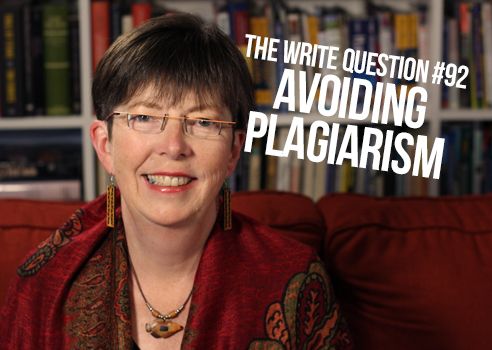Viewing time: 5 mins. 56 secs.
The Write Question is a weekly video podcast all about writing. Today’s question is how to avoid plagiarizing. If you have a question you’d like me to answer you can email me at daphne@publicationcoach.com, tweet me @pubcoach, or leave a message for me at the Skype account, The Write Question.
Transcript
Welcome to The Write Question, I’m Daphne Gray-Grant and my topic today is how to avoid plagiarism.
I have an email from Meredith Slater, a grad student based in San Antonio, Texas. Here’s what she’s asked:
“I read a lot and it’s sometimes difficult to know if an idea originated with me, or if I’m remembering something I read elsewhere. The opposite sometimes happens, too. I’ll be reading over my notes on an article and notice that my own reflections are mixed in with my summary of the article. What can I do to avoid becoming the accidental plagiarist?”
Thanks for your question, Meredith. Plagiarism strikes fear in the hearts of many writers for a good reason. In college or university it can lead us to failing an entire course or even, getting expelled.
Professors typically run all papers through software allowing them to identify plagiarized work, or, worse, students who have bought their work outright from “essay-mills” — disreputable companies that earn their money by writing papers for pay.
The snare of plagiarism has even trapped some professionals. Former New Yorker writer and book author Jonah Lehrer got himself into major trouble when he re-used text from earlier books and articles in newer ones. This practice is called self-plagiarism. The New Yorker kept him on until others discovered that he had manufactured several quotes from musician Bob Dylan in his book Imagine: How Creativity Works. The publisher immediately pulled the book from the shelves and pulped all remaining copies. (This is really too bad because otherwise, it’s an excellent book. See link below with a story from Slate about Jonah Leher’s troubles.)
Even the late Helen Keller faced plagiarism charges. Keller had had suffered an illness at the age of 19 months that robbed her of both her hearing and vision. Keller had many tantrums so, to help calm the wild child, her family hired a helper — Annie Sullivan — to act as a teacher and companion. Sullivan quickly taught the girl to communicate by using sign language that she spelled into her open hands.
Keller was a bright, articulate young woman and wrote a story, The Frost King at the age of 11, as a birthday gift for a family friend. The friend had it published in an alumni magazine and a journal for the blind. Quickly, however, critics identified the story as shocking similar to another tale, The Frost Fairies, by a different writer. Although Alexander Graham Bell and Mark Twain both defended Keller’s writing, the public humiliation scarred Keller for decades.
You don’t want this to happen to YOU. You’ve already taken the first step by being aware that plagiarism is a problem. Now you need to take some more concrete actions to avoid plagiarizing. Here’s what I suggest:
Develop really rigorous ways of storing your research. I like to use the software Evernote (see link below) but if you’re an academic you might want to use storage software that will also format your citations. Mendeley, Zotoro and Citavi will all do that. Links below. The great thing about all these pieces of software is that they’ll let you import PDFs. That way, you can save all the peer-reviewed journal articles you’d like, and then use an electronic highlighter to mark them up. Put your own notes in the margins and then it will be clear to you that those notes are YOUR own thoughts.
If you use a another person’s words, you need to quote them directly. If you use another person’s ideas, you need to credit them.
Whenever you’re making notes develop the habit of always differentiating between your ideas and those belonging to someone else. Develop your own note-taking style so that your unique thoughts appear in a certain form. Perhaps you could put them in italics? Or highlight them in a particular colour? Develop your own “code” and don’t ever get sloppy about using it, particularly if you’re working on a long paper like a thesis or dissertation. You can’t count on your memory. Always document exactly what you do.
As the final protective step to avoid plagiarizing, I suggest you always run your work through a plagiarism checker before submitting it. I subscribe to Grammarly, which provides plagiarism checking. But you can also use other sources, some of which are free. Names include Small SEO tools, Plagly and WriteCheck. Links to all of these programs below.
The secret to protecting yourself from plagiarism is to have really good work habits that you use diligently.
Finally, let me wrap up with a quote from Lady Marguerite Gardiner, Countess of Blessington. “Borrowed thoughts, like borrowed money, only show the poverty of the borrower.”
Meredith, I know that plagiarism is frightening and it might seem like an arbitrary bit of bad luck. It’s not. Plagiarism tends to occur when people haven’t developed diligent work habits. With careful planning you can protect yourself against it. Take the necessary steps.
Links:
How to juggle research with writing
An earlier version of this post first appeared on my blog on May 24/19.


